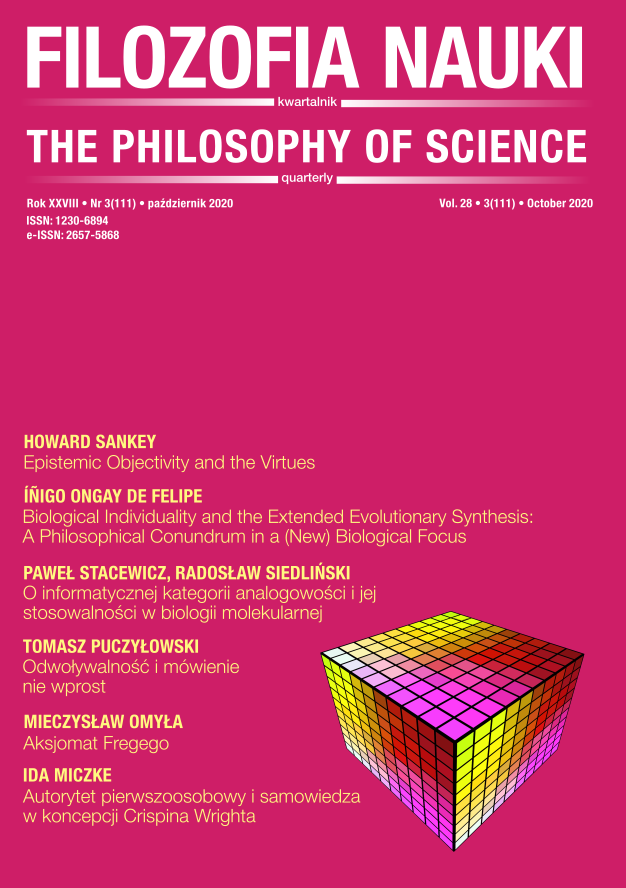Biological Individuality and the Extended Evolutionary Synthesis: A Philosophical Conundrum in a (New) Biological Focus
DOI:
https://doi.org/10.14394/filnau.2020.0014Słowa kluczowe:
evolution, individuality, modern synthesis, extended evolutionary synthesisAbstrakt
There has been much debate in evolutionary biology concerning the extension of some of the central tenets of the modern synthesis (MS). Due to recent developments in evolutionary developmental biology (Evo-Devo), epigenetics, phenotypic and developmental plasticity, niche construction and ecological inheritance, and animal traditions, an increasing array of leading evolutionary biologists, theoretical biologists, and philosophers of biology agree that the structure of the MS needs to be reconsidered. This paper reflects on the connection between this scientific debate and the notion of biological individuality. The paper proposes a discussion of two levels at which the concept of individuality intersects with the extended evolutionary synthesis (EES), as well as the tension between two roles for individuals in such an extended theoretical framework. First, taken at face value, many developments in evolutionary thinking point to an organismcentered view of evolutionary processes. Second, the concept of individuality appears to have been hugely modified in the history of evolutionary thought. Indeed, both multilevel selection theory and the framing of Darwinian individuality transitioning among levels in evolution entail an expansion of the notion of individuality. Such an extended notion leaves room for aggregations of (classical) organisms counting as evolutionary individuals while (allegedly proper) organisms may coherently be viewed as populations. It follows that while individuality has become increasingly relevant for the renewed view of evolution that the EES presents, the boundaries of the notion seem blurrier and more fluid than ever. The paper concludes with a call for pluralism with regard to individuals (and many other evolutionary concepts).
Bibliografia
Baedke J., Fábregas-Tejeda A., Vergara-Silva F. (2020), “Does the Extended Evolutionary Synthesis Entail Extended Explanatory Power,” Biology and Philosophy 35(20). https://doi.org/10.1007/s10539-020-9736-5
Bueno G. (2013), Sciences as Categorial Closures, Oviedo: Pentalfa.
Bueno G. (2016), El Ego Trascendental, Oviedo: Pentalfa.
Bueno O., Chen R.-L., Fagan M. B. (eds.) (2018), Individuation, Process and Scientific Practices, Oxford: Oxford University Press. https://doi.org/10.1093/oso/978019063 6814.003.0001
Bunge M. (1963), The Myth of Simplicity, Englewood Cliffs: Prentice-Hall.
Buskell A. (2019), “Reciprocal Causation and the Extended Evolutionary Synthesis,” Biological Theory 14, 267-279. https://doi.org/10.1007/s13752-019-00325-7
Buss L. (1987), The Evolution of Individuality, Princeton, NJ: Princeton University Press.
Cartwright N. (1999), The Dappled Word: A Study of the Boundaries of Science, Oxford: Oxford University Press. https://doi.org/10.1017/CBO9781139167093
Chancellor G. (2005), “Levels of Selection in Darwin’s Origin of Species,” History and Philosophy of the Life Sciences 37(2), 131-157. https://doi.org/10.1007/s40656-015-0067-9
Chang H. (2012), Is Water H2O? Evidence, Realism and Pluralism, Cambridge: Cambridge University Press.
Clarke E. (2010), “The Problem of Biological Individuality,” Biological Theory 5(4), 312-325. https://doi.org/10.1162/BIOT_a_00068
Clarke E. (2012), “Plant Individuality: A Solution to the Demographer’s Dilemma,” Biology and Philosophy 27(3), 321-361. https://doi.org/10.1007/s10539-012-9309-3
Clarke E. (2013), “The Multiple Realizability of Biological Individuals,” Journal of Philosophy 110(8), 413-435. https://doi.org/10.5840/jphil2013110817
Clarke E. (2016), “Levels of Selections in Biofilms: Multispecies Biofilms Are Not Evolutionary Individuals,” Biology and Philosophy 31(2), 191-212. https://doi.org/10.1007/ s10539-016-9517-3
Clarke E. (forthcoming), “Is Evolution Fundamental When It Comes To Defining Biological Ontology? Yes” [in:] Current Controversies in Philosophy of Science, S. Dasgupta, R. Dotan, B. Weslake (eds.), Routledge.
Darwin C. (1859), On the Origin of Species by Means of Natural Selection, London: John Murray.
Darwin C. (1868), The Variation of Animals and Plants under Domestication, London: John Murray.
Darwin C. (1871), The Descent of Man, and Selection in Relation to Sex, London: John Murray. https://doi.org/10.5962/bhl.title.2092
Darwin C. (1872), The Expression of Emotions in Man and Animals, London: John Murray. https://doi.org/10.1037/10001-000
Dawkins R. (1976), The Selfish Gene, Oxford: Oxford University Press.
Dennett D. C. (2017), From Bacteria to Bach and Back: The Evolution of Minds, New York–London: Norton.
Dobzhansky T. (1937), Genetics and the Origin of Species, New York: Columbia University Press.
Doolittle W. F. (2013), “Microbial Neopleomorphism,” Biology and Philosophy 28, 351-378. https://doi.org/10.1007/s10539-012-9358-7
Dupré J. (1993), The Disorder of Things: Metaphysical Foundations of the Disunity of Science, Cambridge, MA: Harvard University Press.
Dupré J (1999), “On the Impossibility of a Monistic Account of Species” [in:] Species, R. A. Wilson (ed.), Cambridge, MA: MIT Press, 3-22.
Dupré J. (2012), Processes of Life: Essays in the Philosophy of Biology, Oxford: Oxford University Press.
Dupré J. (2018), “Processes, Organisms, Kinds and the Inevitability of Pluralism” [in:] Individuation, Process and Scientific Practices, O. Bueno, R.-L. Chen, M. B. Fagan (eds.), Oxford: Oxford University Press. https://doi.org/10.1093/oso/9780190636814.003.0002
Dupré J., Nicholson D. J. (eds.) (2018), Everything Flows: Towards a Processual Philosophy of Biology, Oxford: Oxford University Press. https://doi.org/10.1093/oso/9780198779636.003.0001
Ereshefsky M., Pedroso M. (2013), “Biological Individuality: The Case of Microfilms,” Biology and Philosophy 28(2), 331-349. https://doi.org/10.1007/s10539-012-9340-4
Fisher R. A. (1918), “The Correlation between Relatives on the Supposition of Mendelian Inheritance,” Transactions of the Royal Society of Edinburgh 52(2), 399-433.
Folse H., Roughgarden J. (2010), “What Is an Individual Organism? A Multilevel Selection Perspective,” The Quarterly Review of Biology 84(4), 447-472. https://doi.org/10.1086/656905
Fusco G., Minelli A. (2010), “Phenotypic Plasticity in Development and Evolution: Facts and Concepts,” Philosophical Transactions of the Royal Society B 365, 547-556. https://doi.org/10.1098/rstb.2009.0267
Gardner A., Úbeda F. (2017), “The Meaning of Intragenomic Conflict,” Nature Ecology and Evolution 1, 1807-1815. https://doi.org/10.1038/s41559-017-0354-9
Ghiselin M. T. (1974), “A Radical Solution to the Species Problem,” Systematic Zoology 23, 536-544. https://doi.org/10.1093/sysbio/23.4.536
Gilbert S. F. (2014), “A Holobiont Birth Narrative: The Epigenetic Transmission of Human Microbiome,” Frontiers in Genetics 5, 282. https://doi.org/10.3389/fgene.2014.00282
Gilbert S. F., Sapp J., Tauber A. (2012), “A Symbiotic View of Life: We Have Never Been Individuals,” The Quarterly Review of Biology 87(4), 325-341. https://doi.org/10.1086/668166
Gilbert S. F., Tauber A. I. (2016), “Rethinking Individuality: The Dialectics of Holobiont,” Biology and Philosophy 31(6): 839-853. https://doi.org/10.1007/s10539-016-9541-3
Godfrey-Smith P. (2009), Darwinian Populations and Natural Selection, Oxford: Oxford University Press. https://doi.org/10.1093/acprof:osobl/9780199552047.001.0001
Godfrey-Smith P. (2013), “Darwinian Individuals” [in:] From Groups to Individuals: Perspectives on Biological Associations and Emerging Individuality, F. Bouchard, P. Huneman (eds.), Cambridge, MA: MIT Press.
Gould S. J. (2002), The Structure of Evolutionary Theory, Cambridge, MA: Harvard University Press.
Hempel C., Oppenheim P. (1948), “Studies in the Logic of Explanation,” Philosophy of Science 15: 135-175. https://doi.org/10.1086/286983
Hölldobler B., Wilson E. O. (2008), The Superorganism: The Beauty, Elegance and Strangeness of Insect Societies, New York: Norton.
Hull D. L. (1976), “Are Species Really Individuals?,” Systematic Zoology 25(2), 174-191. https://doi.org/10.2307/2412744
Huneman P. (2019), “Special Issue Editor’s Introduction: Revisiting the Modern Synthesis,” Journal of the History of Biology 52(4), 509-518. https://doi.org/10.1007/s10739-019-09585-2
Hurst L. D. (1992), “Intragenomic Conflict as an Evolutionary Force,” Proceedings: Biological Sciences 248(1322): 135-140. https://doi.org/10.1098/rspb.1992.0053
Huxley J. (1942), Evolution: The Modern Synthesis, London: Allen and Unwin.
Jablonka E., Lamb M. (2008), “Soft Inheritance: Challenging the Modern Synthesis,” Genetics and Molecular Biology 31(2). https://doi.org/10.1590/S1415-47572008000300001
Lafuente E., Beldade P. (2019), “Genetics of Developmental Plasticity in Animals,” Frontiers in Genetics 10(720). https://doi.org/10.3389/fgene.2019.00720
Laland K., Sterelny K., Odling-Smee J., Hoppitt W., Uller T. (2011), “Cause and Effect in Biology Revisited: Is Mayr’s Proximate–Ultimate Dichotomy Still Useful?,” Science 334(6062): 1512-1516. https://doi.org/10.1126/science.1210879
Laland K., Odling-Smee J., Hoppit W., Uller T. (2013), “More on How and Why: Cause and Effect in Biology Revisited,” Biology and Philosophy 28(5): 719-745. https://doi.org/10.1007/s10539-012-9335-1
Laland K., Uller T., Feldman M .W., …, Strassmann J. E. (2014), “Does Evolutionary Theory Need a Rethink? Point: Yes, Urgently,” Nature 514(7521), 161-164. https://doi.org/10.1038/514161a
Laland K., Matthews B., Feldman M. W. (2016), “An Introduction to Niche Construction Theory,” Evolutionary Ecology 30, 191-202. https://doi.org/10.1007/s10682-016-9821-z
Lamarck J. B. (1914), Zoological Philosophy: An Exposition with Regard to the Natural History of Animals, London: Macmillan. https://doi.org/10.5962/bhl.title.57305
Lea A. J., Tung J., Archie E. A., Alberts S. C. (2017), “Developmental Plasticity: Bridging Research in Evolution and Human Health,” Evolution, Medicine and Public Health 2017(1), 162-175. https://doi.org/10.1093/emph/eox019
Lewontin R. C., Gould S. J. (1979), “The Spandrels of San Marco and the Panglossian Paradigm: A Critique of the Adaptationist Programme,” Proceedings of the Royal Society London B 205, 581-598. https://doi.org/10.1098/rspb.1979.0086
Maynard-Smith J., Szathmáry E. (1995), The Major Transitions in Evolution, Oxford: Oxford University Press.
Mayr E. (1940), “Speciation Phenomena in Birds,” The American Naturalist 74 (752), 249-278. https://doi.org/10.1086/280892
Mayr E. (1942), Systematics and the Origin of Species, New York: Columbia University Press.
Mayr E. (1961), “Cause and Effect in Biology,” Science 134 (3489), 1501-1506. https://doi.org/10.1126/science.134.3489.1501
Mayr E. (1993), “Proximate and Ultimate Causation,” Biology and Philosophy 8, 95-98. https://doi.org/10.1007/BF00868508
Mayr E., Provine W. B. (1980), The Evolutionary Synthesis: Perspectives on the Unification of Biology, Cambridge, MA: Harvard University Press.
McConwell A. (2017), “Contingency and Individuality: A Plurality of Evolutionary Individuality Types,” Philosophy of Science 84(5), 1104-116. https://doi.org/10.1086/694010
Mitchell S. D. (2002), “Integrative Pluralism,” Biology and Philosophy 17, 55-70. https://doi.org/10.1023/A:1012990030867
Müller G. B. (2014), “EvoDevo Shapes the Extended Synthesis,” Biological Theory 9, 1119-1121. https://doi.org/10.1007/s13752-014-0179-6
Müller G. B. (2017), “Why an Extended Evolutionary Synthesis is Necessary,” Interface Focus 7(5). https://doi.org/10.1098/rsfs.2017.0015
Nagel E. (1970), “Issues in the Logic of Reductive Explanations” [in:] Mind, Science and History, H. E. Kiefer, K. M. Munitz (eds.), Albany, NY: SUNY Press, 117-137.
Noble D. (2015), “Conrad Waddington and the Origin of Epigenetics,” Journal of Experimental Biology 218, 816-818. https://doi.org/10.1242/jeb.120071
Nowak P. G. (2019), “The Notion of an Organism in a Context of a Brain Death Debate” [in:] What Is an Individual Organism? Philosophical Problems, the book of abstracts of an international conference in Kraków, Institute of Philosophy, Jagiellonian University, Department of Philosophy of Natural Sciences, 11 October 2019 (https://bit.ly/3kwggXw), 10-11.
Odling-Smee F. J., Laland K. N., Feldman M. W. (2003), Niche Construction: The Neglected Process in Evolution, Princeton, NJ: Princeton University Press.
Ongay I. (2018a), “The Principle of Parsimony and How August Weismann Used It,” Ludus Vitalis 26(50): 17-33.
Ongay I. (2018b), “The Dappled World of Evolutionary Biology: Scientific Pluralism and the Extended Evolutionary Synthesis” [in:] Actas del IX Congreso de la Sociedad de Lógica, Metodología y filosofía de la Ciencia en España, C. Saborido, S. Ems, J. González de Prado (eds.), Madrid, 365-366.
Ongay I. (2019), “Is Simplicity a Myth: Mach and Bunge on the Principle of Parsimony” [in:] Mario Bunge: A Centenary Festschrift, M. R. Matthews (ed.), Cham: Springer: 163-180. https://doi.org/10.1007/978-3-030-16673-1_9
Orgel L. E., Crick F. H. (1980): “Selfish DNA: The Ultimate Parasite,” Nature 284, 604-607. https://doi.org/10.1038/284604a0
Pigliucci M. (2008), “Is Evolvability Evolvable?,” Nature Review Genetics 9: 75-82. https://doi.org/10.1038/nrg2278
Pigliucci M., Müller G. B. (2010), Evolution, the Extended Synthesis, Cambridge, MA: MIT Press. https://doi.org/10.7551/mitpress/9780262513678.001.0001
Pradeu T. (2013), “Immunity and the Emergence of Individuality” [in:] From Groups to Individuals: Evolution and Emerging Individuality, F. Brouchard, P. Huneman (eds.), Cambridge, MA: MIT Press.
Pradeu T. (2016a), “The Many Faces of Biological Individuality,” Biology and Philosophy 31, 761-773. https://doi.org/10.1007/s10539-016-9553-z
Pradeu T. (2016b), “Organisms or Biological Individuals? Combining Physiological and Evolutionary Individuality,” Biology and Philosophy 31(6), 797-817. https://doi.org/10.1007/s10539-016-9551-1
Pradeu T. (2019), “Philosophy of Biology: Immunology and Individuality,” eLife 2019(8), e48374. https://doi.org/10.7554/eLife.47384
Pradeu T. (2020), Philosophy of Immunology, Cambridge, MA: Cambridge University Press.
Romanes G. (1893), An Examination of Weismannism, London: Longmans Green. https://doi.org/10.1037/12955-000
Santelices B. (1999), “How Many Kinds of Individuals Are There?,” Tree 14(4), 152-155. https://doi.org/10.1016/S0169-5347(98)01519-5
Şencan S. (2019), “A Tale of Two Individuality Accounts and Integrative Pluralism,” Philosophy of Science 86(5), 1111-1122. https://doi.org/10.1086/705523
Seung H. S. (2011), “Towards Functional Connectomics,” Nature 471, 171-172. https://doi.org/10.1038/471170a
Smocovitis V. B. (1992), “Unifying Biology: The Evolutionary Synthesis and Evolutionary Biology,” Journal of the History of Biology 25(1), 1-65. https://doi.org/10.1007/BF01947504
Smocovitis V. B. (1997), Unifying Biology: The Evolutionary Synthesis and Evolutionary Biology, Princeton, NJ: Princeton University Press.
Sober E. (2015), Ockham’s Razors: A User’s Manual, Cambridge, MA: Cambridge University Press. https://doi.org/10.1017/CBO9781107705937
Sober E., Wilson D. S. (1998), Unto Others: The Evolution and Psychology of Unselfish Behavior, Cambridge, MA: Harvard University Press.
Stencel A. (2019), “Holobionts and Biological Individuality” [in:] What Is an Individual Organism? Philosophical Problems, the book of abstracts of an international conference in Kraków, Institute of Philosophy, Jagiellonian University, Department of Philosophy of Natural Sciences, 11 October 2019 (https://bit.ly/3kwggXw), 12-13.
Uller T., Laland K. (2019), Evolutionary Causation: Biological and Philosophical Reflections, Cambridge, MA: MIT Press. https://doi.org/10.7551/mitpress/11693.001.0001
Vrba E. S, Eldredge N. (1984), “Individuals, Hierarchies and Processes: Towards a More Complete Evolutionary Theory,” Paleobiology 10(2), 146-171. https://doi.org/10.1017/S0094837300008149
Waddington C. H. (1942), “Canalization of Development and the Inheritance of Acquired Characters,” Nature 150, 563-565. https://doi.org/10.1038/150563a0
Waddington C. H. (1953), “Genetic Assimilation of an Acquired Character,” Evolution 7(2), 118-126. https://doi.org/10.1111/j.1558-5646.1953.tb00070.x
Weismann A. (1893), Die Allmacht der Natürzuchtung, eine Erwiderung an Herbert Spencer, Jena: Fischer.
Werren J. H. (2011), “Selfish Genetic Elements, Genetic Conflicts and Evolutionary Innovation,” PNAS 108(2). https://doi.org/10.1073/pnas.1102343108
West-Eberhard M. J. (2005), Developmental Plasticity and Evolution, Oxford: Oxford University Press.
Williams G. C. (1966), Adaptation and Natural Selection, Princeton, NJ: Princeton University Press.
Wilson E. O. (2012), The Social Conquest of Earth, New York: Liveright.
Wilson E. O., Wilson D. S. (2007), “Rethinking the Theoretical Foundation of Sociobiology,” The Quarterly Review of Biology 82(4), 327-348. https://doi.org/10.1086/522809
Wray G. A., Hoekstra H. E., Futuyma D. J., Lenski R. E. (2014), “Does Evolutionary Theory Need a Rethink? Counterpoint: No, All Is Well,” Nature 515: 161-164. https://doi.org/10.1038/514161a



















 Filozofia Nauki | ISSN 1230-6894 | e-ISSN 2657-5868
Filozofia Nauki | ISSN 1230-6894 | e-ISSN 2657-5868